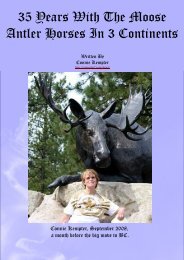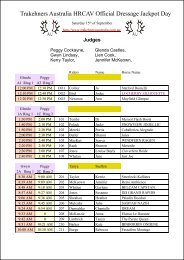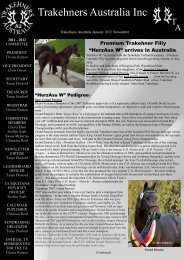8'800 Price neg. 0437 — 800 — 339 or celestialpark@iinet.net.au
8'800 Price neg. 0437 — 800 — 339 or celestialpark@iinet.net.au
8'800 Price neg. 0437 — 800 — 339 or celestialpark@iinet.net.au
Create successful ePaper yourself
Turn your PDF publications into a flip-book with our unique Google optimized e-Paper software.
Trakehners Australia Inc<br />
TA NEWSLETTER DECEMBER 2011 ISSUE<br />
EQUITANA Greasy Heel 2011<br />
The condition is also referred to as Photo aggravated vasculitis and most<br />
commonly affects the mature h<strong>or</strong>se, in particular the h<strong>or</strong>ses with no pigmentation<br />
of the skin in the lower limb extremities such as the pastern <strong>or</strong> fetlock<br />
<strong>or</strong> heel bulb. The multiple lesions that occur in these areas are well defined<br />
and will present with the following visuals.<br />
* A redness <strong>or</strong> reddening of the entire area<br />
* Oozing and open crusted s<strong>or</strong>es develop<br />
* Swelling of the affected limb occurs.<br />
* Sometimes in chronic cases, it will take<br />
on a crusty wart like appearance.<br />
My own (Painth<strong>or</strong>se) presented<br />
with the condition as a 4 yo. Like<br />
most people I first thought it was a<br />
simple case of 'greasy heel'. It appeared<br />
identical to that condition. I<br />
treated the condition with all the<br />
usual 'scrub the scabs off', plaster<br />
it in a drying agent, used a wide<br />
range of other products -Potties,<br />
Illium Neoc<strong>or</strong>te, Prednoderm, yellow<br />
lotion, copper sulphate spray,<br />
Zinc etc. etc. you name it, I tried it<br />
and all to no avail. All these different<br />
treatments only served only to<br />
aggravate the condition.<br />
Despite these treatments, it was as if I had thrown an accelerant on a fire,<br />
the condition quickly w<strong>or</strong>sened and spread upward at an alarming rate. This<br />
treatment period was in the vicinity of about 2 months and still no further advanced<br />
in so far as curing the complaint. The h<strong>or</strong>se by this time was extremely<br />
tender and s<strong>or</strong>e and reluctant to allow touch to the area.<br />
After considerable weeks of consulting with different other veterinarians and<br />
alternating various treatments of the range of products and potions, I was at<br />
wits end and fast running out of ideas when I accidentally found a rather<br />
small book written by Profess<strong>or</strong> Reginald Pascoe, a w<strong>or</strong>ld recognised equine<br />
veterinary <strong>au</strong>th<strong>or</strong>ity, and within the pages of this small publication, Prof. Pascoe<br />
described to a letter the condition my h<strong>or</strong>se was suffering.<br />
The article also gave the known cure f<strong>or</strong> the condition - the application of a<br />
topical c<strong>or</strong>tisone.<br />
T A







